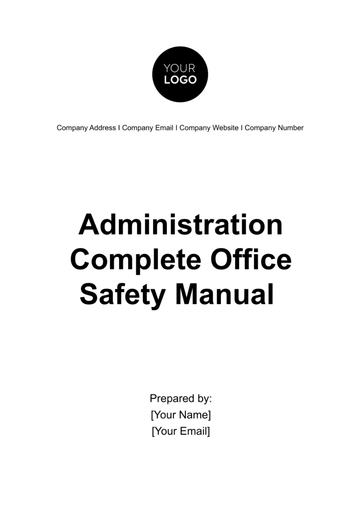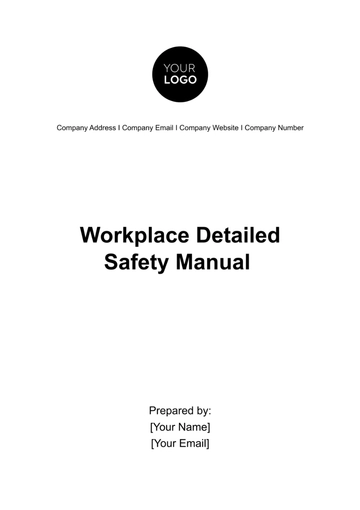Free Simple Safety Training Manual

Prepared by: [Your Name]
Date: [Date]
I. Introduction to Fire Safety
This manual is designed to equip all employees with the fundamental knowledge of fire safety protocols and procedures in the workplace. The primary goal is to ensure that everyone understands how to prevent fire hazards, recognize potential risks, and respond effectively in the event of an emergency. Adhering to fire safety guidelines helps protect lives, property, and the continuity of business operations.
II. Understanding Fire Hazards
Fires can occur due to various causes, and it is essential to identify and mitigate potential fire hazards in the workplace. Some of the most common fire hazards include:
Electrical Hazards:
Overloaded circuits, faulty or exposed wiring, malfunctioning equipment, and improper use of electrical appliances can lead to electrical fires. In 2050, advanced AI-operated systems control much of the electrical infrastructure, but human vigilance is still crucial in detecting anomalies.
Combustible Materials:
Materials such as paper, textiles, and chemicals stored inappropriately near heat sources increase the risk of fire. In the evolving workplace of 2050, nanomaterials and advanced polymers are frequently used, requiring specialized storage protocols.
Flammable Liquids:
Mishandling or improper storage of flammable liquids such as oils, solvents, and gases can easily lead to fires. Even with the development of safer synthetic alternatives, traditional chemicals still pose risks when mishandled.
III. Preventative Measures
Taking proactive steps to reduce the risk of fires is a responsibility shared by all employees. Implement the following practices to enhance workplace safety:
Regular Equipment Inspections:
Ensure that electrical equipment and AI-operated systems are inspected frequently for wear and tear. Advanced diagnostic software available in 2050 can assist with the early detection of electrical faults, but human supervision is necessary to ensure optimal functioning.
Safe Storage of Combustible and Flammable Materials:
Store all materials—especially advanced synthetic compounds and volatile chemicals—away from heat sources and direct sunlight. Use designated fireproof containers and rooms to minimize risk.
Maintain Clean Workspaces:
Clutter can obstruct escape routes and increase fire risk. Ensure waste materials are disposed of correctly in specialized recycling units, which have evolved to handle advanced materials and nanowaste by 2050.
Install and Maintain Smoke Detectors:
Ensure AI-integrated smoke detectors and advanced fire suppression systems are installed in key locations. These systems now possess early fire detection capabilities, including temperature anomalies, making them an indispensable tool for modern fire prevention.
IV. Emergency Procedures
In the event of a fire, employees should follow these steps to ensure a safe and orderly evacuation:
Activate Fire Alarms:
Trigger the nearest smart fire alarm, which will automatically notify emergency services in the year 2050, along with alerting building management systems.Evacuate and Call Emergency Services:
After activating the alarm, evacuate the premises immediately and contact emergency services through the AI-augmented communication systems.Follow Escape Routes:
Use designated escape routes marked with AI-guided lights and emergency navigation. These systems are designed to provide real-time directions and avoid high-risk areas.Assist Evacuees:
Assist co-workers, particularly those with disabilities or unfamiliar with the building. AI-enabled robots and drones, now standard in 2050, may also assist in rescue operations.Report to Assembly Points:
Assemble at the designated safety zones equipped with emergency communication systems and medical supplies. Do not re-enter the building until cleared by emergency responders and AI risk assessment systems.
V. Fire Extinguisher Usage
It is essential to know the location of fire extinguishers and how to use them properly. Different types of extinguishers are designed for specific types of fires:
Type | Used For |
|---|---|
Water Extinguisher | Fires involving combustible materials like paper, wood, and textiles |
Foam Extinguisher | Fires caused by flammable liquids and solid materials |
CO2 Extinguisher | Electrical fires and flammable liquids |
How to Use a Fire Extinguisher - Remember PASS:
Pull the pin: Remove the safety pin to unlock the extinguisher.
Aim the nozzle: Direct it at the base of the fire.
Squeeze the handle: Press to release the extinguishing agent.
Sweep from side to side: Move the nozzle in a sweeping motion until the fire is out.
VI. Compliance Requirements
To ensure fire safety compliance, companies must adhere to both local and global safety standards. In 2050, regulations have advanced, and smart buildings are required to meet higher safety standards.
Fire Drills and Inspections:
Conduct regular fire drills with the assistance of AI monitoring systems to evaluate readiness. Schedule periodic inspections to identify potential hazards before they become a risk.
Fire Safety Training:
Provide comprehensive fire safety training to all employees, including instruction on modern fire safety tools and technologies. Training can now be conducted using virtual reality simulations to prepare employees for real-life emergencies.
Clear Exit Routes:
Ensure that emergency exits and escape routes are always clear of obstructions. AI-managed building systems can assist by continuously monitoring exit accessibility and reporting potential issues.
Maintain Records:
Keep up-to-date records of fire safety inspections, training sessions, and incident reports. By 2050, these records are likely to be stored in cloud-based systems accessible by both company management and regulatory authorities.
VII. Conclusion
Fire safety remains a cornerstone of workplace safety, even in the advanced technological landscape of 2050 and beyond. By following the guidelines set out in this manual, employees contribute to a safer, more secure work environment. Regular training and awareness are critical, as they can prevent accidents and mitigate the impact of fire-related incidents. With the advent of advanced safety technologies, employees must stay informed and take proactive steps to maintain fire safety at all times.
- 100% Customizable, free editor
- Access 1 Million+ Templates, photo’s & graphics
- Download or share as a template
- Click and replace photos, graphics, text, backgrounds
- Resize, crop, AI write & more
- Access advanced editor
Template.net's Simple Safety Training Manual Template provides a straightforward and customizable format for ensuring workplace safety. This template is fully editable in our Ai Editor Tool, allowing you to customize safety protocols, procedures, and emergency response guidelines effortlessly. Ideal for organizations seeking to maintain a safe environment, this template simplifies the process of developing essential training manuals with clear, easy-to-follow content tailored to your needs.





























